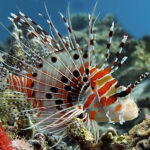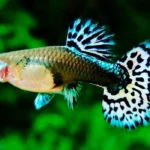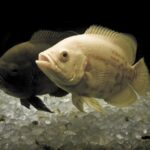Why Angelfish?
Angelfish: Elegant, gliding motion and wing-like fins make angelfish a popular freshwater species.
Originating from the Amazon Basin in South America, they add natural beauty to any aquarium.
Known for their striking shape, patterns, and unique personalities.
Relatively hardy, making them a top choice for beginner to intermediate aquarists.
A perfect blend of grace and character in your tank.

Angelfish Varieties and Colors
Multiple color morphs developed through selective breeding.
Common types include
Silver Angelfish—Most likely the wild version, with vertical black stripes and a silvery body.
Veil Tail Angelfish—Longer, flowing fins.
Marble Angelfish—Black, white, and gold marble patterns.
Gold Angelfish—Bright golden-yellow hues.
Black Angelfish—Deep black body, striking in planted tanks.
Koi Angelfish—Orange, white, and black patches like koi fish.
Each variant may have slightly different needs in terms of sensitivity and visibility.
Tank Size and Setup
Minimum tank size: 20 gallons for a pair; 30+ gallons recommended for a small group.
Tall tanks are preferable due to their vertical fin span.
Important features to include:
Plants (live or silk) for cover and resting spots.
Open swimming areas in the center.
Driftwood or vertical structures mimicking submerged roots.
Filtration:
Use a gentle filter—angelfish dislike strong currents.
Sponge filters or adjustable hang-on-back filters work well.
Lighting:
Moderate lighting—bright enough for plants but not harsh.
8–10 hours of light daily to mimic natural rhythms.
Substrate:
Sand or fine gravel is preferred.
Avoid sharp substrates that may damage their fins.
Water Parameters and Conditions
Angelfish prefer stable, tropical freshwater conditions.
Water quality is critical.
Perform weekly water changes (20–30%).

Social Behavior and Tank Mates
Best kept:
In small groups, when young, establish hierarchy early.
In mated pairs as adults, reduce fighting and stress.
Avoid fin-nipping species like barbs.
Compatible tank mates:
Corydoras catfish
Plecos (small types)
Mollies
Swordtails
Gouramis (non-aggressive species)
Tetras (larger ones like black skirt or bleeding heart)
Incompatible tank mates:
Betta fish (due to fin aggression)
Tiger barbs
Oscars
Guppies (may get harassed)
Watch for bullying or harassment during feeding and breeding periods.
Feeding and Diet
Omnivores with a preference for protein-rich food.
Diet should include:
High-quality flakes and pellets (as a staple).
Frozen or live foods: bloodworms, brine shrimp, daphnia.
Vegetables: blanched spinach or zucchini (occasionally).
Freeze-dried treats (moderate use).
Feeding schedule:
2–3 small meals per day.
Remove uneaten food after 3–5 minutes to prevent water quality issues.
Overfeeding leads to:
Obesity
Constipation
Water fouling
Use fasting days (once per week) to promote digestive health.
Breeding Angelfish
Breeding in captivity is common but requires care and preparation.
Sexual differences:
Males may have a more pronounced forehead (nuchal hump).
Females may appear rounder when full of eggs.
Spawning setup:
Breeding pair tank: 20–30 gallons with sponge filter.
Flat surfaces like breeding slats or leaves for egg laying.
Spawning behavior:
The pair will clean the surface and lay 100–500 eggs.
The male fertilizes after laying.
Parental care:
Parents may guard and fan eggs.
Some pairs eat their eggs; use an egg separator if needed.
Hatching:
Eggs hatch in ~2 days, free-swimming in 5–7 days.
Feed fry with infusoria, then baby brine shrimp.

Common Health Issues
Ich (white spot disease):
Caused by a parasite; appears as white specks on the body/fins.
Treat with temperature increase and aquarium salt/medication.
Fin rot:
Bacteria cause frayed or decaying fins.
Triggered by poor water or stress, treat with antibacterial medication.
Velvet disease:
Golden dust-like coating, caused by parasites.
Needs quick treatment—dim lighting and copper-based meds.
Hole-in-the-head disease:
Seen as small pits on the head and face.
Linked to poor diet and water quality; treat with metronidazole.
Preventative care:
Quarantine new fish.
Maintain stable water.
Feed a balanced diet.
Signs of Stress and Unhappiness
Clamped fins or hiding behavior.
Gasping at the surface.
Loss of appetite.
Pale coloration or darkening.
Erratic swimming or lying at the bottom.
Sudden aggression or lethargy.
Address stressors quickly:
Check water quality.
Ensure proper temperature.
Reduce tank mate aggression.
Tips for Long-Term Success
Stick to a regular maintenance schedule.
Observe your fish daily for changes in behavior.
Use quality food brands with proper nutrient balance.
Provide vertical space and hiding spots.
Fun Facts About Angelfish
They can recognize their owners and often “beg” for food.
Communicate through body language and fin movements.
Their long fins can span nearly the height of their tank.
Capable of forming lifelong pair bonds.
Their name “angelfish” comes from their wing-like appearance.
One of the most bred freshwater fish in the hobby industry.
Angelfish in Aquascaping
Complement well with Amazon-style tanks.
Tall plants like Vallisneria or Amazon sword mimic the native environment.
Pair well with driftwood and leaf litter for a natural biotope look.
Slow water movement is ideal for aquascaped tanks.
Their vertical form contrasts beautifully with horizontal elements.

Conclusion
Angelfish are the real gem of the freshwater aquarium hobbyist; they are elegant, smart, and fascinating to watch. The payoff is worth the effort, even if they do need a bit more attention than some of the other species for beginners.
These elegant swimmers will live on for years if the tank setup, water conditions, diet, and tank mates are right. Your bond with them will become stronger as you become aware of their social requirements, natural behavior, and reproduction patterns.
You are not only taking care of fish; you are also curating a living work of art, whether you are adding your first angelfish or managing a dedicated breeding pair. They will be the focal point of any tank—and of your aquatic hobby—because of their charm, individuality, and beauty.
FAQs
How many angelfish can I keep together?
1 per 10 gallons is a safe estimate; best in pairs or small groups.
Can angelfish live alone?
Yes, but they do better with social interaction.
Do angelfish nip fins?
Occasionally, especially when stressed or territorial.
Do they need an air pump?
Not always—if the filter provides surface agitation, it’s sufficient
How many angelfish can I keep in one tank?
A general rule is one angelfish per 10 gallons.
For a community or group, a 30–55 gallon tank is recommended.
Avoid overcrowding to reduce aggression and territorial behavior.
Can angelfish live alone?
Yes, angelfish can live alone and still thrive.
However, they are social fish and often do better in pairs or small groups, especially if raised together.
How long do angelfish live?
With proper care, angelfish typically live 8 to 10 years.
Some can live even longer with excellent tank conditions and nutrition.










